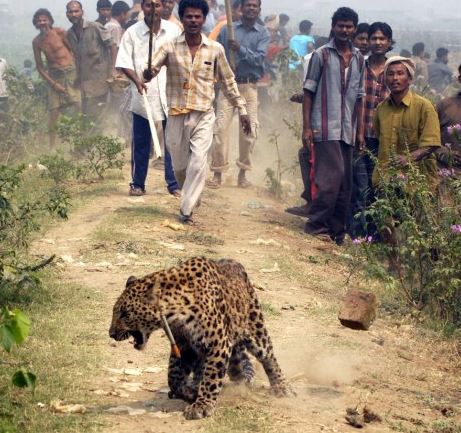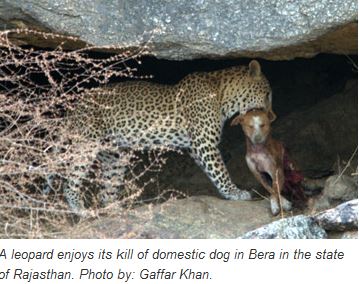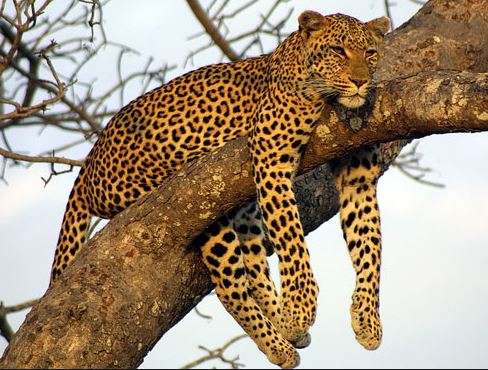It looks like you're using an Ad Blocker.
Please white-list or disable AboveTopSecret.com in your ad-blocking tool.
Thank you.
Some features of ATS will be disabled while you continue to use an ad-blocker.
26
share:
GPS-leopards stay out of our way

A recent study in India has shown that leopards can live amongst us in almost complete secrecy. They were found to move within the outskirts of population centres and laid low during the daytime.
In the first-ever GPS-based study of leopards in India, led by WCS and partners has delved into the secret lives of these big cats, and recorded their strategies to thrive in human-dominated areas.
The study concludes that leopards in human areas are not always 'stray' or 'conflict' animals but residents, potentially requiring policy makers to rethink India's leopard-management strategies.
Next-door leopards: First GPS-collar study reveals how leopards live with people
Five leopards (two males and three females) perceived as "problem animals" and captured from human-dominated areas despite no predatory attack on people, were radio-collared for the study. Two were translocated and released more than 50 km (31 miles) away, while the remaining three were released near the site of capture.
The scientists monitored the animals' activities from the time of release, for up to a year, recording their behavior -- including strategies they adopt to avoid direct contact with people.
There are several points in the study that bear attention. The first is that relocating the big cats can be a pointless exercise as they gravitate to human populations anyway. This is inevitably due to humans having everything that a leopard could want: food, water, territory. Expanding urbanisation may well have created generations of these big fellas that are more familiar with artificial territories than natural ones.
Secondly, the sample animals suggest that leopards are not always the risk to humans that popular myths would have us believe. They seem well adapted to existing alongside us without overtly intruding in our lives or attacking. These ones have travelled for miles within human communities and used strategies that actively avoid human/leopard interactions. One of the males is a whopping 63kg of muscle, teeth and claws and would dominate most people if it went after humans.

Nevertheless, we might draw parallels with western red/urban foxes that eventually begin to encroach on human habitats and can become confident to the point of aggression. Every so often, people and babies are attacked by these nocturnal scavengers. Leopards are similar to foxes in the way they operate in small family groups rather than forming packs. If India took the bold step of leaving leopards alone, they might just find a rising population competing with people for territory and food resources.
There used to be leopard-related deaths in their thousands during the late 19th Century and they’ve reduced considerably towards the late 20th Century. Despite our never-ending expansion into the wilderness that was once theirs, their populations are fragmenting and dying out at a fast rate. Unsurprisingly, there's also a black-market of poaching accounting for hundreds of deaths per year. This is possibly why human deaths have decreased even as our populations increase and continue to live alongside them.

A separate study investigated the diets of urban leopards and found their primary prey to be dogs and cats. There’s no way to identify how many of these domesticated critters were pets and were missed. There’s always been a huge population of feral cats and dogs in India so it’s probable that these weren’t missed and actually represent a great resource. Again it highlights how a big cat can live on the threshold of human society and barely be noticeable.
The study, which looked at scat samples for leopards in India's Ahmednagar's district in Maharashtra, found that 87 percent of their diet was made up of domestic animals. Domestic dog dominated as the most common prey item at 39 percent and domestic cats were second at 15 percent.
Seventeen percent of the leopard's diet consisted of assorted wild animals including rodents, monkeys, and mongoose, and birds.
Read more at: phys.org...

Big black cats?
This is ATS so we have to add a little mystery-spice here to add intrigue. Big black cats have been reported in the UK and Australia for many years and some of the reports I’ve read genuinely sound like the descriptions of very big critters. Then again, every photo I've seen looks like a domestic cat with rarely any context for size so who knows?

The report leaves us a little room to speculate that a small population of big cats could live alongside us without spurring too many incidents or confirmation. Instead of chowing down on farm animals, they could exist on birds, rabbits and occasional domestic pets. If leopards can live within the outskirts of highly-populated places like Mumbai, is it possible they can live in the less densely populated areas of semi-rural UK and Australia?
Whatever the case, leopards find themselves surviving on the thresholds of our world and hiding in the shadows. Sadly, they also find themselves dwelling within the shaded areas betwixt extinction and survival.

a reply to: Kandinsky
Do they live amongst us up here in Quebec too, where temperature can go down to -40 C during winter, with total accumulations if snow on the ground ranging in the 4 to 6 feet?
Maybe it ius true for India, but I have my doubts for some other places on the Globe.
Do they live amongst us up here in Quebec too, where temperature can go down to -40 C during winter, with total accumulations if snow on the ground ranging in the 4 to 6 feet?
Maybe it ius true for India, but I have my doubts for some other places on the Globe.
Great thread
Cought my attention straight away , Im gonna print this out and add it to my file .
I live in SW Sydney Australia and there are multiple hotspots for these big cats fifteen minutes up the road from me .
Some good friends of mine have even seen them .
The media around here tends to throw the same light on this subject as they do about the boogeyman.
There are actually people here that have begun tracking these things full time , SNF.
Cought my attention straight away , Im gonna print this out and add it to my file .
I live in SW Sydney Australia and there are multiple hotspots for these big cats fifteen minutes up the road from me .
Some good friends of mine have even seen them .
The media around here tends to throw the same light on this subject as they do about the boogeyman.
There are actually people here that have begun tracking these things full time , SNF.
Fascinating, but googling this subject I found the following:
Link
Most don't do this of course but just this one might ruin it for the rest of them The human species is a scourge to the world, if I wouldn't know better I'd think we are like a biblical plague to all the other species.
I do admire the cunningness of these animals and how they manage to outsmart the locals And as for the big black cats... well I don't know, never really dived into the subject.
Link
The killer responsible for 12 gruesome deaths in northern India isn't a human – it's a man-eating leopard. And villagers in the region, who now live in terror of traveling through the forest at night, believe the big cat is targeting drunk men, stumbling home from local bars.
"Villagers are terrorized by the wild animals and it's almost impossible to venture out after dark," Madan Paneru from Kotali village told the Telegraph. "Moving from one village to another or to markets through forested area becomes difficult. People carry sticks with them and remain alert all the time. Many in the village believe that drunk people are easy prey."
The leopard, according to the report, has killed 12 villagers since January 2012, including two women, and has injured four others. The 10 to 12-year-old animal is believed to have last attacked a human on Sept. 11. The victim survived but was severely injured.
Local wildlife officials, however, aren't completely convinced the animal is fixated solely on drunks, insisting that some of the victims were attacked after using outside toilets.
"Quite frankly, when people are drunk and weave their way back home to the village, they are easy prey," Belinda Wright, who heads up the Wildlife Protection Society of India, said in the Telegraph story. "I don't think the leopard is targeting drunk people, just people stumbling along the path at night. I'm sure you won't taste any better because you've consumed liquor."
Although protected by strict conservation laws, attacks by leopards and tigers have increased in recent years as their habitats shrink, forcing them to wander into populated areas in search of food.
In February of this year, armed trackers and sharp shooters riding atop elephants were dispatched into the forests of the north Indian state of Uttar Pradesh to hunt a tiger that had killed eight villagers in a four-week period, eating five of them.
Weeks later in the same region, a leopard that strayed into a hospital and movie theater in Meerut injured two and prompted the authorities to urge the closure of the city's outdoor markets. It was last seen, according to the New Zealand Herald leaping off a building, forcing locals, hoping to catch a glimpse of the big cat, to run for their lives.
dnan is the guy who local officials have turned to for help with their big cat problem. Earlier this year, Adnan spent more than three weeks roaming area forests and sugar cane fields, hoping to prevent the man-eating tiger in western Uttar Pradesh from claiming its ninth victim.
"A tiger never stops eating man once it has developed a taste for human flesh," he told The Australian. "Even if you shoot at her, she will still try and attack you.''
Most don't do this of course but just this one might ruin it for the rest of them The human species is a scourge to the world, if I wouldn't know better I'd think we are like a biblical plague to all the other species.
I do admire the cunningness of these animals and how they manage to outsmart the locals And as for the big black cats... well I don't know, never really dived into the subject.
a reply to: Omega85
Thanks
The study and news articles caught my attention and seemed good for a thread. The association with big black cats came about because I tend to argue that they'd never be able to exist among us. The paper suggests that, in some circumstances, they possibly could.
Still, it's the idea that leopards cohabitate with unsuspecting people that caught my eye. Just a few weeks ago, I saw a wild deer and I'm in a fairly urban part of NW England. It's sometimes surprising that large animals can go unnoticed by so many.
Thanks
The study and news articles caught my attention and seemed good for a thread. The association with big black cats came about because I tend to argue that they'd never be able to exist among us. The paper suggests that, in some circumstances, they possibly could.
Still, it's the idea that leopards cohabitate with unsuspecting people that caught my eye. Just a few weeks ago, I saw a wild deer and I'm in a fairly urban part of NW England. It's sometimes surprising that large animals can go unnoticed by so many.
a reply to: Pitou
No, there's no escaping that fact that leopards have attacked a lot of people over the years. Some of which have been seemingly drawn to human meat for dinner. I've read several cases where notorious maneater tigers and leopards were weakened by tooth decay, age or other ailments. They'd become too weak to succeed at taking down their usual prey and found people a much easier meal-deal.
I guess no matter whether they lie low amongst us or kill a few people, they are apex predators and it's what they live for. As neither of us live in India or face the threat of apex predators on our streets, we can feel sorry for the leopards and hope the Indian communities continue to translocate rather than kill them on sight.
No, there's no escaping that fact that leopards have attacked a lot of people over the years. Some of which have been seemingly drawn to human meat for dinner. I've read several cases where notorious maneater tigers and leopards were weakened by tooth decay, age or other ailments. They'd become too weak to succeed at taking down their usual prey and found people a much easier meal-deal.
I guess no matter whether they lie low amongst us or kill a few people, they are apex predators and it's what they live for. As neither of us live in India or face the threat of apex predators on our streets, we can feel sorry for the leopards and hope the Indian communities continue to translocate rather than kill them on sight.
My husband took me fossil hunting in Eastern Ohio near Sardinia. He grew up there and found fossils in a creek bed. We were walking around in rubber
boots looking for fossils in the creek when I noticed some large paw prints. Larger than a large dogs in the mud. I followed the prints some. My
husband's looking for rocks and I am seeing a half eaten deer carcass, and a dead big bird carcass with in twenty feet of each other. I was standing
between two bridges. One was an old covered bridge no longer used, and the other the new modern two lane overpass bridge. I was starting to think big
cat and felt like we were being watched. I wanted to leave.
When we got back to his mother's she said someone's exotic cat escaped a while back, and was never caught in Mt Orab Ohio. I looked it up on the internet, and it was true. I also discovered this situation happens a lot, and these cats find the North American cats and mate with them. Our USA cats have African cat blood and DNA now. The authorities don't want to publically admit what is happening because they don't want to deal with it and all the liability associated. No it's not safe to just go out with out a riffle in the woods for a walk. Remember the guy who let a whole bunch of exotic cats loose in Ohio near Columbus? This was a few months after my experience. We did manage to find a fossil of a cephalopod.
When we got back to his mother's she said someone's exotic cat escaped a while back, and was never caught in Mt Orab Ohio. I looked it up on the internet, and it was true. I also discovered this situation happens a lot, and these cats find the North American cats and mate with them. Our USA cats have African cat blood and DNA now. The authorities don't want to publically admit what is happening because they don't want to deal with it and all the liability associated. No it's not safe to just go out with out a riffle in the woods for a walk. Remember the guy who let a whole bunch of exotic cats loose in Ohio near Columbus? This was a few months after my experience. We did manage to find a fossil of a cephalopod.
a reply to: swanne
Thankfully, Canada's big cats are just cougars. Still deadly, just not as big.
And they love the snow.....
There was a news report just yesterday about an 80 year old Alberta man saving his little dog from a cougar.
I won't walk around our forests or rural areas without carrying a big stick, there's just too many coyotes and cougars.
At least the wolves and coyotes stay on the ground, big cats like to drop from trees and cliffs
Thankfully, Canada's big cats are just cougars. Still deadly, just not as big.
And they love the snow.....
There was a news report just yesterday about an 80 year old Alberta man saving his little dog from a cougar.
I won't walk around our forests or rural areas without carrying a big stick, there's just too many coyotes and cougars.
At least the wolves and coyotes stay on the ground, big cats like to drop from trees and cliffs
a reply to: snowspirit
Around here it's mostly bears. You need a kinda powerful gun, they are just so massive. And you have to aim.
Around here it's mostly bears. You need a kinda powerful gun, they are just so massive. And you have to aim.
a reply to: Kandinsky
I wonder if people are one of the unhealthier meats that they eat, with all the junk we eat, we must be a really high cholesterol meal....
I've read several cases where notorious maneater tigers and leopards were weakened by tooth decay, age or other ailments. They'd become too weak to succeed at taking down their usual prey and found people a much easier meal-deal.
I wonder if people are one of the unhealthier meats that they eat, with all the junk we eat, we must be a really high cholesterol meal....
Maybe if the locals started putting fluoride in the leopards water supply, they would become docile and too lazy to attack.
Great thread by the way! S+F
It looks like humans aren't the only thing on the menu.
Cats kill up to 3.7B birds annually
I'll admit, I had no idea it was this many. And a lot of these deaths are attributed by "cats that live among us".
Great thread by the way! S+F
It looks like humans aren't the only thing on the menu.
Cats kill up to 3.7B birds annually
Cats that live in the wild or indoor pets allowed to roam outdoors kill from 1.4 billion to as many as 3.7 billion birds in the continental U.S. each year, says a new study that escalates a decades-old debate over the feline threat to native animals.
The estimates are much higher than the hundreds of millions of annual bird deaths previously attributed to cats. The study also says that from 6.9 billion to as many as 20.7 billion mammals — mainly mice, shrews, rabbits and voles — are killed by cats annually in the contiguous 48 states. The report is scheduled to be published Tuesday in Nature Communications.
I'll admit, I had no idea it was this many. And a lot of these deaths are attributed by "cats that live among us".
"Our findings suggest that free-ranging cats cause substantially greater wildlife mortality than previously thought and are likely the single greatest source of anthropogenic mortality for U.S. birds and mammals," Marra and his co-authors conclude. "Scientifically sound conservation and policy intervention is needed to reduce this impact."
edit on 23-11-2014 by eisegesis because: (no reason given)
new topics
-
George Knapp AMA on DI
Area 51 and other Facilities: 2 hours ago -
Not Aliens but a Nazi Occult Inspired and then Science Rendered Design.
Aliens and UFOs: 3 hours ago -
Louisiana Lawmakers Seek to Limit Public Access to Government Records
Political Issues: 5 hours ago -
The Tories may be wiped out after the Election - Serves them Right
Regional Politics: 6 hours ago -
So I saw about 30 UFOs in formation last night.
Aliens and UFOs: 8 hours ago -
Do we live in a simulation similar to The Matrix 1999?
ATS Skunk Works: 9 hours ago -
BREAKING: O’Keefe Media Uncovers who is really running the White House
US Political Madness: 10 hours ago -
Biden--My Uncle Was Eaten By Cannibals
US Political Madness: 11 hours ago -
"We're All Hamas" Heard at Columbia University Protests
Social Issues and Civil Unrest: 11 hours ago
top topics
-
BREAKING: O’Keefe Media Uncovers who is really running the White House
US Political Madness: 10 hours ago, 23 flags -
Biden--My Uncle Was Eaten By Cannibals
US Political Madness: 11 hours ago, 18 flags -
George Knapp AMA on DI
Area 51 and other Facilities: 2 hours ago, 16 flags -
African "Newcomers" Tell NYC They Don't Like the Free Food or Shelter They've Been Given
Social Issues and Civil Unrest: 16 hours ago, 12 flags -
Russia Flooding
Fragile Earth: 17 hours ago, 7 flags -
"We're All Hamas" Heard at Columbia University Protests
Social Issues and Civil Unrest: 11 hours ago, 7 flags -
Russian intelligence officer: explosions at defense factories in the USA and Wales may be sabotage
Weaponry: 15 hours ago, 6 flags -
Louisiana Lawmakers Seek to Limit Public Access to Government Records
Political Issues: 5 hours ago, 6 flags -
So I saw about 30 UFOs in formation last night.
Aliens and UFOs: 8 hours ago, 5 flags -
The Tories may be wiped out after the Election - Serves them Right
Regional Politics: 6 hours ago, 3 flags
active topics
-
"We're All Hamas" Heard at Columbia University Protests
Social Issues and Civil Unrest • 124 • : DBCowboy -
Biden--My Uncle Was Eaten By Cannibals
US Political Madness • 40 • : Kaiju666 -
Candidate TRUMP Now Has Crazy Judge JUAN MERCHAN After Him - The Stormy Daniels Hush-Money Case.
Political Conspiracies • 364 • : RazorV66 -
MULTIPLE SKYMASTER MESSAGES GOING OUT
World War Three • 29 • : annonentity -
Alabama Man Detonated Explosive Device Outside of the State Attorney General’s Office
Social Issues and Civil Unrest • 57 • : watchitburn -
Not Aliens but a Nazi Occult Inspired and then Science Rendered Design.
Aliens and UFOs • 6 • : visitedbythem -
Russian intelligence officer: explosions at defense factories in the USA and Wales may be sabotage
Weaponry • 165 • : andy06shake -
The Tories may be wiped out after the Election - Serves them Right
Regional Politics • 18 • : alldaylong -
Silent Moments --In Memory of Beloved Member TDDA
Short Stories • 43 • : Naftalin -
What do you do to get to sleep and stay asleep ??
Health & Wellness • 108 • : TheGoondockSaint
26
